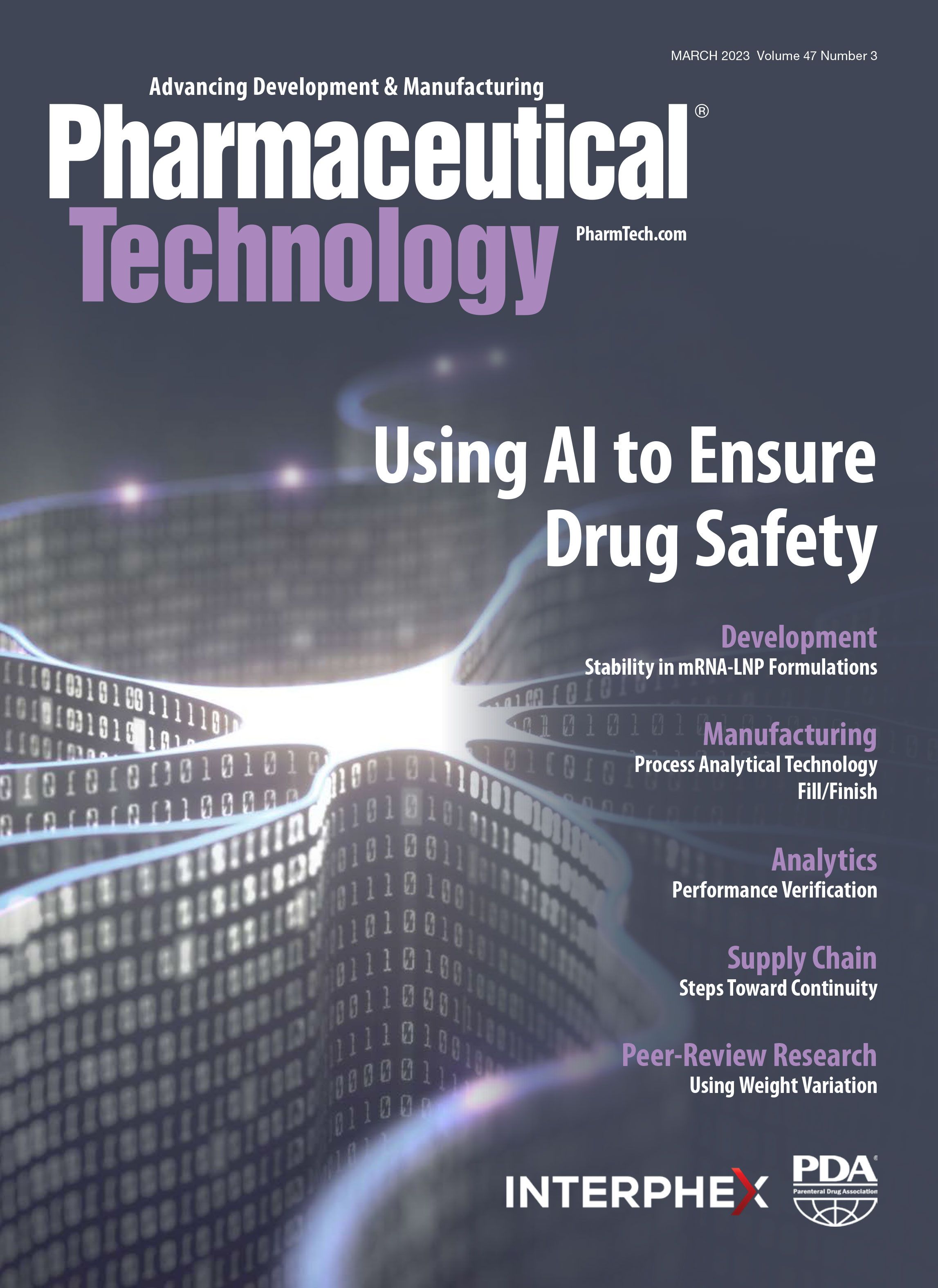Implementing Process Analytical Technology
PAT is crucial to process control and real-time release in continuous manufacturing of solid-dosage drugs.
greenbutterfly - stock.adobe.com

PAT is crucial to process control and real-time release in continuous manufacturing of solid-dosage drugs.
Advances in process analytical technology (PAT) are enabling increased use of in-line PAT instruments for real-time measurement in continuous manufacturing (CM) of oral solid dosage (OSD) drugs. Broad use of PAT is crucial in development stages to build understanding of the product and process. In commercial manufacturing, manufacturer’s strategies for how and where to use PAT on continuous production lines varies (1), but the tools are an essential part of real-time quality control.
Near infrared (NIR) spectroscopy is one of the commonly used PAT instruments in OSD CM, typically for measuring the amount of API to allow real-time tracking of content uniformity. Raman spectroscopy is also finding use for real-time content uniformity and other measurements. These in-line spectroscopy tools use a probe inserted into the process stream or an interface that views the process material through a window to detect the signal to be measured. These in-line tools do not need sample collection or preparation; they are non-destructive and provide real-time data, which can be combined with residence-time distribution (RTD) models to allow real-time process monitoring and control.
“The use of RTD in continuous manufacturing of tablets was started at Rutgers more than 15 years ago, and it is now common to use this approach,” says Fernando Muzzio, distinguished professor at the School of Engineering at Rutgers, The State University of New Jersey and member of the Pharmaceutical Technology® Editorial Advisory Board. “PAT identifies a disturbance in the process, and you then use RTD to define a diversion interval to predict which portion of the product stream should be diverted. The RTD is calculated from the point where the sensor takes the measurement of the perturbation to the point of diversion,” he explains.
Muzzio’s research group at Rutgers has been working with eight industry participants—including pharmaceutical manufacturers, equipment suppliers, and a contract development and manufacturing organization (CDMO)—on an FDA-funded project to evaluate the RTD approach. “We have demonstrated that RTD can be implemented in different rigs for different products. It is a flexible tool,” Muzzio says.
Faster NIR sensors
The Rutgers research group has also evaluated next-generation, multi-point NIR spatially resolved spectroscopy (SRS) probes and found that they provide accurate and fast measurement, typically with a 3-ms acquisition time, that can detect even a single agglomerate in a blend, says Muzzio. “We have demonstrated that you can measure an agglomerate size distribution, which enables a more thorough characterization of blends. With the accuracy and speed of this technology, you can get close to 100% inspection of tablets coming through a tablet press at 200,000 tablets/hr,” he reports. The sensor technology is offered by multiple vendors and has been integrated into commercial tableting and inspection equipment, such as the inspection system from Pharma Technology (1).
Real-time Raman
Adoption of Raman within CM is increasing due to its applicability and affordability. “Recent developments have made Raman easier to use, more stable in calibration, and smaller in size [compared to earlier Raman technology]. These innovations have also made Raman scalable by reducing the cost to acquire and implement the technology,” explains Brian Marquardt, founder and CEO of MarqMetrix.
Marquardt says that Raman is currently used for the real-time monitoring of API production and for real-time release in final drug products. “Raman provides immediate chemical feedback for the identification of molecules and their corresponding concentrations that must be controlled for API, OSD, or other final product quality,” he explains. “By understanding the composition of the drug intermediate and/or final product, companies can reduce the number of failed batches and prevent significant waste, while simultaneously reducing costs and improving quality.”
Due to the mechanism of measurement, Raman spectroscopy is not impacted by common factors (such as particle size) that can cause variability in API lots. This advantage sets Raman spectroscopy apart from traditional PAT tools, according to Marquardt. Water does not interfere with Raman measurements, which is a significant benefit given the aqueous nature of many pharma applications, he adds. He further explains that some excipients may have fluorescence that can interfere with Raman signals and that moderate fluorescence can be managed mathematically with minimal effect on the Raman data, but in extreme cases, other analytical tools are required.
Improved sample interface technology enables reproducible measurements of solids, liquids, gases, powders, or slurries. In addition, new interfaces that can be applied in “stand-off mode” allow measurement through a process window for non-contact, in-process measurements. This mode can also measure through the wall of a package or container, which can simplify stability studies and avoid impacting sample sterility. Raman spectroscopy can be used, for example, to measure API concentration before tablet compression with either a contact probe in the powder stream or a contact-free interface that measures through a sapphire window. Raman spectroscopy using a high-volume, contactless probe can also be used to measure coating thickness on tablets inside a coater in real-time (2).
CDMOs implement PAT
Physically integrating the PAT probe into the process for accurate measurement is important. Effort must also be put into connecting the instrument to the data collection system and to developing robust models that can use these data to calculate critical quality attributes (CQAs).
Thermo Fisher Scientific is working on PAT models for real-time release (RTR) as the CDMO prepares for its client’s expected 2024 commercial launch of a drug using CM. “We are planning for real-time release and using PAT data as part of our models,” explains Doug Hausner, senior manager of business development for continuous manufacturing at Thermo Fisher Scientific. “The model for content uniformity uses API measurements from the NIR in the tablet press coupled with the mass of the tablets.” The CDMO is integrating its existing stand-alone tablet testers so that data are connected and flow from the test equipment in real-time. In addition, microwave spectroscopy is used to measure moisture content. “This PAT instrument is located after tablet coating, which occurs in a separate suite and is a batch process. These data will also become part of the electronic batch record and be used for RTR,” explains Hausner.
Hausner says that the Thermo Fisher team is conducting a wide range of experiments up front to test how NIR responds to material variations so that anticipated variability can be built into the model to increase its robustness. “For long-term commercial use of CM, it would be useful to have a model-maintenance program to look ahead and identify upcoming changes (e.g., an API change) and to perform any lab work needed to adjust the model,” he suggests.
CDMO WuXi STA, a subsidiary of WuXi AppTec, started up its first CM line for oral solid dosage drug products at its Wuxi, China site, the company announced in January 2023 (3). The CM line uses continuous direct compression for tableting in both development and commercial production and incorporates PAT to monitor blend uniformity before the compression step.
Continuus Pharmaceuticals has been building up its capabilities in end-to-end CM and, more recently, has been developing its role as a CDMO. PAT tools are currently used both in development and pilot-scale manufacturing, says Qinglin Su, associate director of Manufacturing Science & Technology at Continuus. PAT tools being used include in-line NIR, mid-IR, Raman, UV, laser-based particle sizers, and pH and density meters.
“We are designing and building ‘plug-and-play’ unit operation modules to support flexible and efficient commercial continuous manufacturing, both drug substance and drug product. Unit operations are being built with ports in place for current and future PAT implementation,” says Su.
He explains that incorporating PAT into the equipment typically requires custom designs. Many of the PAT tools are interchangeable between development and pilot-scale manufacturing, but others must be designed specifically for the scale at which they will be used.
Implementing PAT for RTR requires a strong understanding of the PAT tools, adds Su. “To best use PAT for developing a RTR strategy, I believe we need greater understanding and more predefined acceptance criteria in the sampling rate/size/accuracy/precision of PAT tools for measurement of critical quality attributes (CQAs),” he says. “Better models for how in-process testing results and critical process parameters (CPPs) can be used to predict CQAs and release specifications are needed for RTR.Demonstrating comparability for in/online testing versus off-line testing is another challenge.”
Moving forward
Using PAT with models to predict tablet dissolution is another area that is moving forward. “PAT data on tablet composition, along with weight and size data collected at the tablet press, can be used to predict dissolution for many formulations. We’ve developed dissolution models in the lab for both prescription and over-the-counter formulations,” says Muzzio. “These models, combined with RTD, enable prediction of dissolution for real-time release.”
Regulators are taking note of the work being accomplished in PAT for CM. For example, the International Council for Harmonisation Q13 guidance for continuous manufacturing, published Jan. 6, 2023 (4), points out that PAT is well-suited for CM (e.g., for process monitoring and control or material tracking and diversion), notes Su. “I believe this guidance will assure the pharmaceutical manufacturing industry of the full support of the regulatory agencies. Regulatory agencies will also start to expect to see PAT implementation for CM,” Su concludes.
Regulations, however, are not yet taking full advantage of the progress of PAT technology, says Muzzio. “Technology has advanced to the point of allowing 100% quality assurance—which could be used for either continuous or batch processes—but the regulatory framework still requires the old methods of sampling in the approval process. Eventually, PAT technology could drive a change both in quality assurance and in the way drugs are approved,” he concludes.
References
- Markarian, J. Breaking Through Barriers to Continuous Manufacturing. Pharm. Tech.2022 46 (4) pp. 16-20.
- Marquardt, B.Raman Detects Pharma Processing Fingerprints. Pharmaceutical Technology, Solid Dosage Drug Development and Manufacturing Supplement, April 2021.
- STA Pharma. WuXi STA Launches First Continuous Manufacturing Line for Oral Solids. Press Release, Jan. 3, 2023.
- ICH. Guideline Q13 on Continuous Manufacturing of Drug Substances and Drug Products, Step 5 (Jan. 6, 2023)
About the Author
Jennifer Markarian is manufacturing report for Pharmaceutical Technology.
Article Details
Pharmaceutical Technology
Volume 47, No.3
March 2023
Pages 24-27
Citation
When referring to this article, please cite it as Markarian, J. Implementing Process Analytical Technology. Pharmaceutical Technology 47 (3) 2023.

Drug Solutions Podcast: A Closer Look at mRNA in Oncology and Vaccines
April 30th 2024In this episode fo the Drug Solutions Podcast, etherna’s vice-president of Technology and Innovation, Stefaan De Koker, discusses the merits and challenges of using mRNA as the foundation for therapeutics in oncology as well as for vaccines.
Pharmaceutical Tariffs Are Imminent: How Industry is Bracing for Impact
April 16th 2025On April 14, 2025, the Trump Administration launched a national security-driven investigation into pharmaceuticals, a move that will likely result in tariffs being placed on pharmaceutical drugs, ingredients, and other components that are imported from outside of the United States.